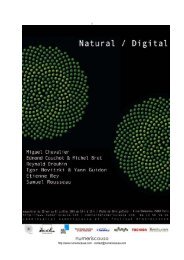Télécharger le pdf de la publication - Reynald Drouhin
Télécharger le pdf de la publication - Reynald Drouhin
Télécharger le pdf de la publication - Reynald Drouhin
You also want an ePaper? Increase the reach of your titles
YUMPU automatically turns print PDFs into web optimized ePapers that Google loves.
44<br />
In that sense, it is not a <strong>le</strong>gacy one can capitalize on but an<br />
irreparab<strong>le</strong> <strong>de</strong>bt to come. Therefore, <strong>Reynald</strong> <strong>Drouhin</strong> keeps<br />
the promise of the mosaic. Traditionally, it is inseparab<strong>le</strong><br />
from the supporting architecture. It is only since the<br />
Renaissance that the image can <strong>de</strong>tach itself from the wall<br />
and become mobi<strong>le</strong>. The artist sets out to overthrow that<br />
tradition, going back to the origins, proposing something<br />
incredib<strong>le</strong>: the basic unit will be a particu<strong>la</strong>r image. The only<br />
referent to the origin of an image is another image, and that<br />
origin weaves the multip<strong>le</strong>, ramified links of the web, our<br />
culture’s seismographic symptom. That formal peg will allow<br />
to join what was and what will come and <strong>de</strong>velop a<br />
Pathosformel. Art dies, is born again and history again<br />
begins, it is again the same thing, and yet different every<br />
time. To return to the question of the mosaic, contradiction<br />
and repetition, <strong>Drouhin</strong> does not imitate the Ancients. No<br />
gran<strong>de</strong>ur, <strong>de</strong>ca<strong>de</strong>nce or renaissance, he enters the time of<br />
memory. Survivance, the returning ghost of that form, does<br />
not obey the mo<strong>de</strong>l of transmission which the archetypal<br />
...................<br />
1. In 1993, David B<strong>la</strong>ir <strong>de</strong>veloped a totally different<br />
approach, this heritage is still perceived today as a<br />
promise to come with the WaxWeb project:<br />
http://www.iath.virginia.edu/wax/<br />
2. Georges Didi-Huberman, L’image survivante -<br />
Histoire <strong>de</strong> l’art et temps <strong>de</strong>s fantômes selon Aby<br />
Warburg, Minuit, Paris, 1992.<br />
3. Acronym for Eco<strong>le</strong> Nationa<strong>le</strong> Supérieure <strong>de</strong>s<br />
beaux-arts, referring to the School of Fine Arts of<br />
Paris. (TN)<br />
4. Jean-François Lyotard, Hei<strong>de</strong>gger et “<strong>le</strong>s juifs”,<br />
Galilée, Paris, 1988.<br />
5. Friedrich Wilhelm Nietzsche, Généalogie <strong>de</strong> <strong>la</strong><br />
mora<strong>le</strong>, Gallimard, Paris, 1985.<br />
6. Jacques Derrida, La Voix et <strong>le</strong> Phénomène, PUF,<br />
1967.<br />
7. Refer to the notion of spatial montage in the works<br />
of Eisenstein and Vertof, as well as Bill Seaman and<br />
Lev Manovich renewing that concept.<br />
8. Bernard Stieg<strong>le</strong>r, La technique et <strong>le</strong> temps,<br />
3 volumes, Galilée.<br />
9. Martin Hei<strong>de</strong>gger, Qu’appel<strong>le</strong>-t-on penser?, PUF,<br />
1959, p. 90.<br />
10. A<strong>le</strong>xandre Kojève, L’idée du déterminisme dans <strong>la</strong><br />
physique, Le Livre <strong>de</strong> Poche, Paris,1990.<br />
11. Lev Manovich, Language of New Media, MIT Press,<br />
2001.<br />
12. Jacques Derrida, De <strong>la</strong> Grammatologie, Minuit,<br />
Paris, 1968.<br />
13. Jay David Bolter et Richard Grusin, Remediation:<br />
Un<strong>de</strong>rstanding New Media, MIT Press, 1999.<br />
14. One could think of Gebhard Sengmül<strong>le</strong>r’s,<br />
imitation of ancient works of art by more recent works of art<br />
would assume, but the incessant trans<strong>la</strong>tion, saying something<br />
instead of something else, speaking in the name of all<br />
but oneself. To this end, one needs a print, the mosaic, and<br />
also disp<strong>la</strong>cements of space and time, and finally, an antithesis,<br />
the image within the image which <strong>de</strong>constructs the re<strong>la</strong>tion<br />
between discretion and continuity. Choosing the mosaic<br />
as origin is adopting an imprint which formally avoids all<br />
localized pathos. Origin as such has never existed. The artist<br />
produces an opening in the survival process: the disturbing<br />
recursion of an image of an image of an image. Difference in<br />
repetition, discontinuity of time and sight. <strong>Reynald</strong> <strong>Drouhin</strong><br />
invites us to a genealogy of the image which is distance within<br />
origin. “Repetition is constituted only through and within the<br />
disguises affecting the terms and re<strong>la</strong>tions of series of reality;<br />
but that is so because it <strong>de</strong>pends on the virtual object as if it<br />
were an immanent instance, whose particu<strong>la</strong>r quality is the<br />
disp<strong>la</strong>cement (…) if pushed, only what is strange is familiar,<br />
and only difference repeats itself.” 15<br />
VinylVi<strong>de</strong>o, which inscribes vi<strong>de</strong>o images on vinyl<br />
records. Since the sixties, this media trans<strong>la</strong>tion<br />
has been possib<strong>le</strong> thanks to another phenomenon,<br />
transfer: films are transferred to vi<strong>de</strong>os, these<br />
vi<strong>de</strong>os are transferred from one format to another,<br />
are digitized, then from a floppy disk to a DVD, etc.<br />
Data is no longer confined to a unique medium.<br />
Well what is more static than a mosaic?<br />
15. Gil<strong>le</strong>s De<strong>le</strong>uze, Différence et Répétition, PUF, 1968,<br />
pp.138-145.<br />
...................<br />
* In English in the original text. (TN)






